RIPARIAN
THE RIVERS SCHOOL | SPRING 2024

HANDS-ON SCIENCE
SETTING THE STAGE FOR STUDENT SUCCESS
PLUS: HOW THE AISNE SELF-STUDY CAME TOGETHER
VISITING ARTISTS BRING THEIR PRACTICE TO CAMPUS
C OMMUNITY AND CONNECTION: THE STATE OF THE SCHOOL

THE RIVERS SCHOOL | SPRING 2024

SETTING THE STAGE FOR STUDENT SUCCESS
PLUS: HOW THE AISNE SELF-STUDY CAME TOGETHER
VISITING ARTISTS BRING THEIR PRACTICE TO CAMPUS
C OMMUNITY AND CONNECTION: THE STATE OF THE SCHOOL

FEATURES
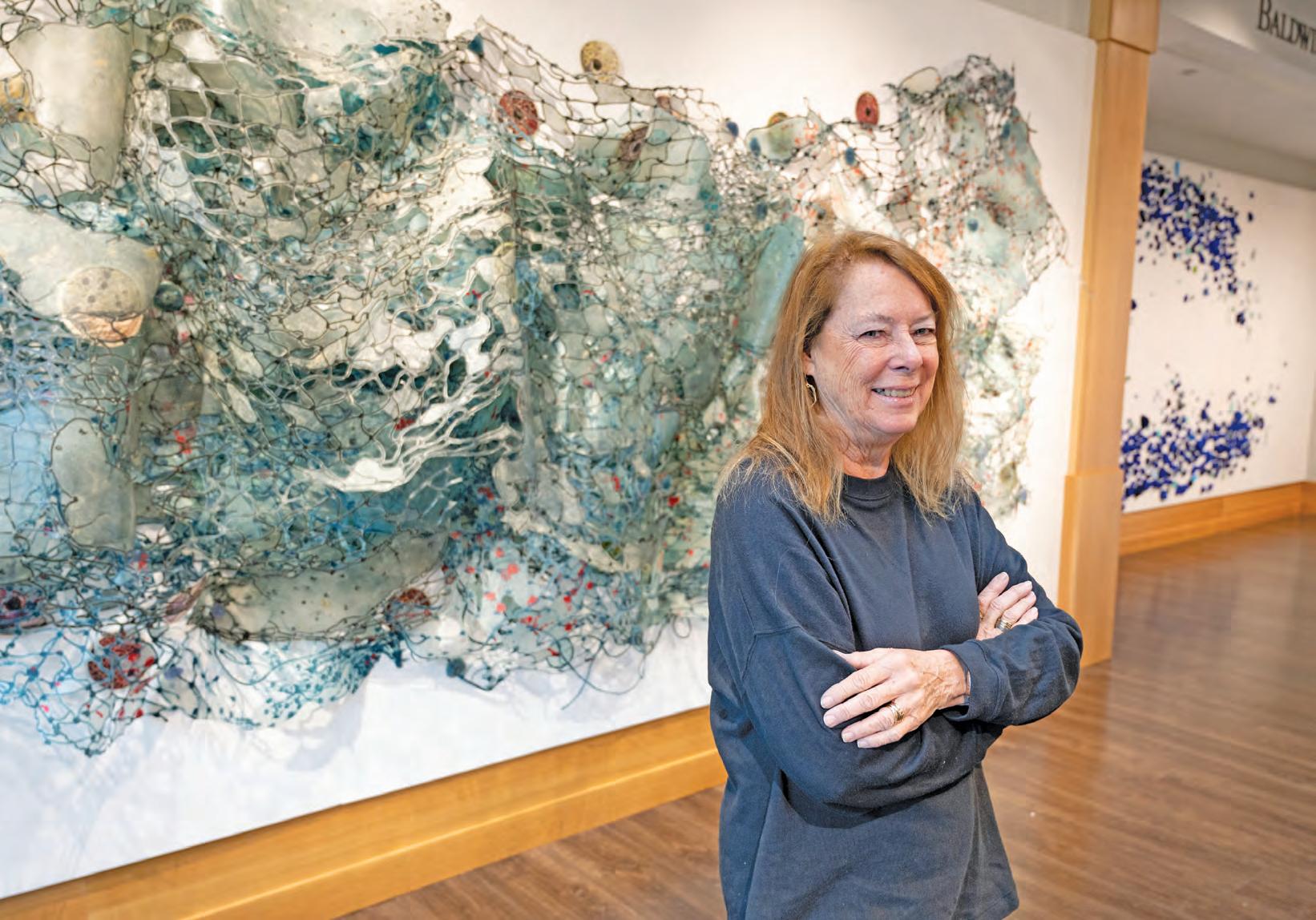
18 THE AISNE FIVE: STEERING THE SELF-STUDY PROCESS
How this “small but mighty” group of professional-community members oversaw the first phase of Rivers’ 10-year accreditation cycle
24 THE VISITING ARTIST PROGRAM
Bringing the practice and purpose of art to campus
28 HANDS-ON SCIENCE
Innovative programs give students experience beyond the classroom



AS A COMMUNITY, we witnessed a celestial phenomenon on April 8 when a solar eclipse traversed Mexico, the United States, and Canada. The anticipation of experiencing near totality was palpable as students, professional-community members, and parents gathered on the Lank Quadrangle to experience this rare event together. As happens so often on the Rivers campus, it was a moment of true connection. In addition to marveling at the near disappearance of the sun, I enjoyed looking into the faces around me for a shared “Wow!” and collective sense of wonder. I was reminded of the power of awe, which University of California, Berkeley professor Dacher Keltner defines as “the feeling of being in the presence of something vast that transcends your current understanding of the world.” Keltner’s research links experiences of awe to increased life satisfaction and a deepened sense of connection with others. Standing in the muted light and dipping temperatures that afternoon amid fellow Rivers community members, I couldn’t agree more.
I also reflected on the fact that the next total eclipse will not occur in the lower 48 states for another 20 years. Looking up that day made me wonder about the future: Where will our students be in 2044? How will they be shaping our world? Will they remember this shared moment? In 20 years, our current students—future scientists, humanists, creators, and changemakers—will surely be leaders in their chosen fields, drawing on the knowledge and skills they gained here at Rivers.
The eclipse also reminded me of the power of experiential learning, one of the many hallmarks that distinguishes a Rivers education, with opportunities for hands-on exploration in and out of the classroom. When The Revers Center for Science and Visual Arts opened, it unlocked many possibilities for students, including—thanks to the labs and equipment available in the new building—the chance to pursue original scientific research. This year, we launched an exciting pilot program designed to do just that. In our new Advanced Topics in Life Sciences Research seminar, and in our science classrooms across the board, students ask
questions and put forth hypotheses, design experiments, analyze data, and draw conclusions based on evidence. They learn how to take risks, make mistakes, and try again. And when they take their new skills and perspectives outside of the classroom, suddenly their world expands.
This issue of the Riparian puts a lens on how science is brought to life at Rivers. You will read about the ways student learning is deepened by real-world experience, as our students learn to think like scientists through experiences as varied as their interests.
And just as our students engage in research, Rivers as an institution has been engaged in an extensive exploration of our entire operation through this year’s self-study, part of our 10-year AISNE accreditation cycle. In these pages, we pay tribute to the “small but mighty” group of professional-community members—known internally as the “AISNE Five”—who led this important work. I would like to thank the members of this team for taking on this significant task that also serves as the first step toward strategic planning and answering the question “What’s next for Rivers?”
As I write this, excitement for our year-end celebrations is building. Planning is underway for Global Fair, Prize Day, and Graduation, while senior speeches, athletic competitions, and student performances continue and classrooms buzz with activity.
The thought of my first year soon coming to a close brings its own sense of wonder, reflection, and even awe. As always, thank you for sharing your children with us. Their joy in learning is evident everywhere at Rivers, on campus and out in the wider world, and I am grateful to be partnering with you in each of their remarkable journeys.
Warmly,
Ryan S. DahlemVOL. XXXVIII NUMBER 2
HEAD OF SCHOOL
Ryan S. Dahlem
EDITOR
Jane Dornbusch
ASSOCIATE HEAD OF SCHOOL FOR DEVELOPMENT AND EXTERNAL RELATIONS
Krissie Kelleher P’22, ’25
DIRECTOR OF MARKETING AND COMMUNICATIONS
Colette Porter
DIRECTOR OF ALUMNI ENGAGEMENT
Janet McKeeney
CONTRIBUTING WRITERS
Rachael Chen, Alexandra Ghiz, Catherine O’Neill Grace
CREATIVE DIRECTOR
Ianka De La Rosa
CONTRIBUTING PHOTOGRAPHERS
Kristie Rae Dean, John Hurley
The Rivers School 333 Winter Street Weston, MA 02493-1040 781.235.9300 www.rivers.org
RIPARIAN: “One that lives or has property on the bank of a river or lake.”
If your contact or mailing information has changed or if you need additional copies mailed to you or other members of your family, please let us know at development@rivers.org.
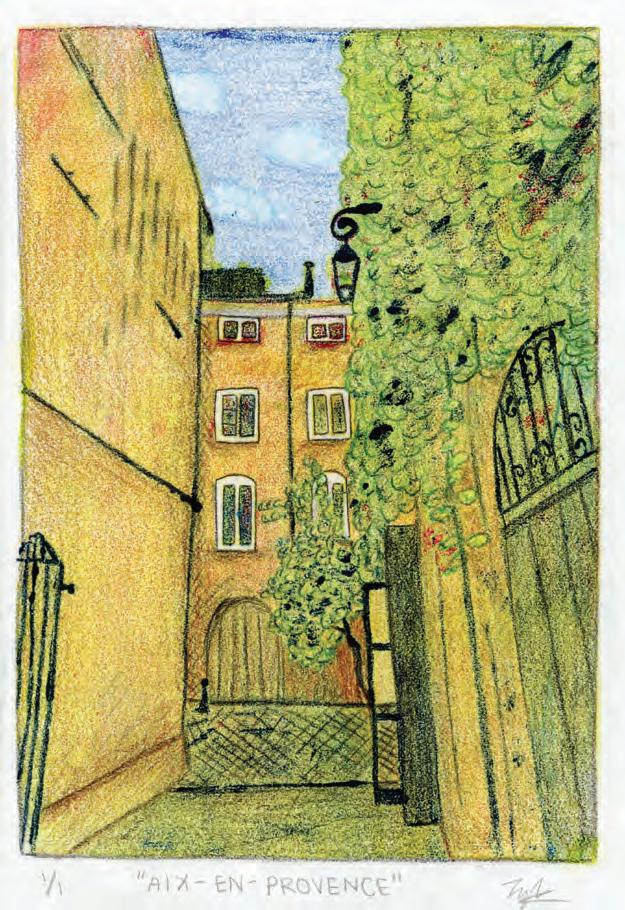
“Aix-en-Provence is CMYK printmaking piece made from layering four colors of ink (cyan, magenta, yellow, and black) and finishing with a light colored-pencil touch-up. This printmaking style is difficult, because you have to think ahead about which colors go where in order to layer them correctly to make a complete and accurate picture. I made this piece based on a photo I took during the Rivers French Exchange Program that I was a part of last year, when we traveled to France for two weeks in June and stayed with our host families. Southern France is so gorgeous, and I wanted to capture the beautiful architecture I saw there.”
—TAYLORHAUFF ’25

A RIVERS SCHOOL EDUCATION emphasizes connection and belonging, placing students at the center of all we do. Our entire professional community of faculty, administrators, and staff encourages healthy risk-taking and works to develop resilience in our students. The Rivers Fund—the school’s primary philanthropic priority—underwrites opportunities for exploration of interests and content that complement our curriculum.
Last year, more than 1,475 donors supported our annual giving program, with parents and caregivers, alumni, faculty, staff, and friends of Rivers contributing over $3.2 million.
Every gift makes an impact, and your yearly participation in this important effort serves as a testament to the dedication and talent of our professional community—and your commitment to Rivers.
To learn more about how The Rivers Fund supports teaching and learning at Rivers, as well as many other aspects of school life, visit our website, rivers.org/giving.

Make your gift to The Rivers Fund today!

Nonesuch Players Deliver Showbiz, Acceptance, and a Lot of Heart in Winter Musical, The Prom
FOUR BROADWAY STARS walk into a tense PTA meeting at a high school in Indiana, where a gay teen has been excluded from attending her prom by the town’s small-minded PTA leadership. The stars are in desperate need of a cause and some rebranding, and the student—well, she just wants to attend her prom with her girlfriend like any other student, yet finds herself in a crossfire of egos, town values, social pressure, and media coverage. Thus the scene was set for Rivers’ winter musical, The Prom, performed by the Nonesuch Players over two nights in February at Regis College. The large ensemble cast, production team, and pit orchestra delighted the audience with the magic of show business, delivering big choreographed
numbers, comedic timing, polished acting and singing, and a powerful, uplifting story of love and acceptance (and many, many sequins!).
The show strikes a balance between a satirical comedy and a poignant story that packs an emotional punch about living proudly and openly. As director Zoë Iacovelli wrote in the program: “This is a story about the freedom to be yourself, love yourself, and support others, which is exactly the type of relationships I witnessed amongst cast, crew, and pit in rehearsals.”
At the “community night” performance of the show, with students, families, and members of the professional community all in attendance, the energy was palpable.
Later Iacovelli said, “Seeing this group of students be so celebrated by their peers was incredible. We couldn’t be more proud of everyone putting their heart and souls on (and off!) the stage. It’s a labor of love for us all and is worth every second of work!” R
TO SEE A GALLERY OF PHOTOS

State of the School Update Charts the Path Forward at Rivers



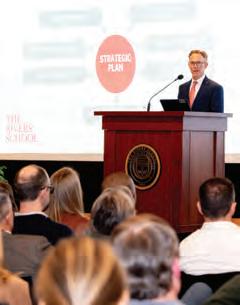


RIVERS HELD AN evening event for parents and caregivers, “Community and Connection: A State of the School Update,” on February 7, providing an overview of the school through a range of lenses: strategy, governance, finance, development, academics, and more. The speakers painted a picture of an institution on an upward trajectory, building on the momentum of Head of School Ryan S. Dahlem’s first six months at the helm.
Following a brief reception, with music provided by a string quartet of Conservatory Program students, Dahlem addressed the crowd of more than 200 gathered in Kraft Dining Hall. He emphasized that, above all, the evening presented an opportunity for connection, a cornerstone of his leadership approach.
Dahlem walked attendees through his six-month reflections, including the five primary goals he set for himself this year (see graphic opposite). He described shadowing Upper and Middle School students throughout their school day, addressed the admission landscape, and added an update on college admissions. He shared survey results showing that the great majority of respondents in the community believe that Rivers places equal emphasis on both excellence and humanity, and that an impressively

Develop Institutional Planning Timeline Lead AISNE Accreditation Study Challenges and Opportunities Immersion in Rivers Community Professional Development
large number of students say they’d be extremely likely to recommend Rivers to a friend.
Updates were also provided by Board President Alan D. Rose, Jr. ’87; CFO Jon Wasserman ’88, P’18, ’21; Krissie Kelleher P’22, ’25, Rivers’ associate head of school for development and external relations; and division heads John Bower and Melissa Anderson P’25, ’25. Rose described the primary functions of the board. Wasserman’s report (presented by Dahlem, as Wasserman was unable to attend) highlighted two central takeaways: that Rivers’ board and administration aspire to manage the school’s overall finances through a
student experience-centered lens, and that, as a nonprofit organization, Rivers creates a mission-oriented, balanced budget each year. Kelleher reviewed the fundraising landscape at Rivers, describing a strong and generous community that routinely steps up to provide the support the school needs. And Bower and Anderson shared programmatic and academic updates from each division, with Bower focusing on the importance of relevance for Middle School students and Anderson emphasizing that the rigorous academics of the Upper School continue to be undergirded with community, connection, and support.
“Learning starts with belonging;
rigor should be embedded in joy; students need oxygen to grow; this is how Excellence with Humanity should look at Rivers,” said Anderson.
Dahlem returned briefly to the podium to speak about preparing for the school’s next chapter. He shared a graphic (below) of the elements that will inform the next strategic plan and a broad timeline for their completion, with the goal of finalizing the plan in spring 2025.
Dahlem concluded by sharing his excitement about being at Rivers, inviting community members to join in the aspirational journey ahead that will continue the school’s remarkable trajectory. R

“AT OUR BEST, WE ARE ONE FAMILY”
FOR THIS YEAR’S Martin Luther King Jr. Day assembly, students gathered for a presentation by jamele adams, a speaker, performer, poet, and DEI practitioner. The high-energy, interactive presentation began with a moving duet of “Lift Every Voice and Sing,” often referred to as the Black national anthem, by Kam Harris ’24 and Head of Middle School John Bower. adams then took to the stage to share his thoughts about community, family, the power of love, and the enduring wisdom of King.
While adams spoke, a group of students and faculty members sat to one side, creating works of art in various media inspired by his remarks. “Art has always been part of the Civil Rights Movement,” adams noted.
The Rivers Select Combo 1 was on hand to provide a jazz background for adams’ remarks. As the group played, adams urged the crowd to “believe that it is possible” for love to conquer hate. “Everything is nothing until we believe it,” he said. “Believe that we can be together. Believe that hate doesn’t have to exist. Believe in forgiveness, not forgetness. Believe in your love.” He expressed the hope that students would “leave this space feeling inspired to do more,” emphasizing that “at our best, we are one family.” R

STUDENTS AND FACULTY
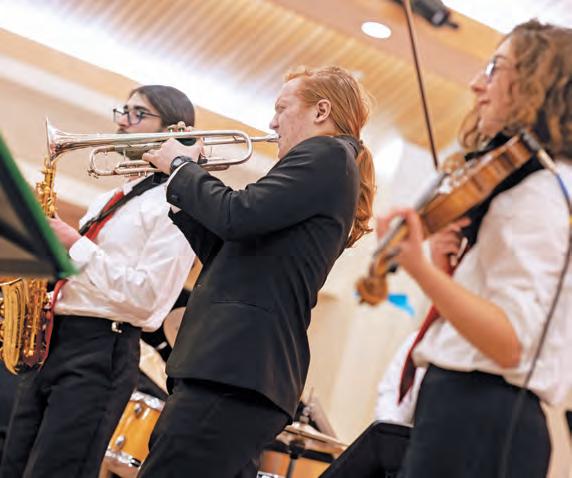
RIVERS AUDIENCES took a musical trip to Latin America in November at the annual Rivers & RSC Jazz Festival. At the centerpiece of the day-long showcase for Rivers and RSC jazz bands was a guest performance by Oscar Stagnaro, a four-time Grammy Award winner, educator, and bass player on the faculty of the Berklee College of Music. Stagnaro and his trio performed a Latin-inflected set with Maxim Lubarsky on piano and Mark Walker on drums. The program also served as a sendoff for Rivers’ jazz trip to Cuba in March, which included students from Noble and Greenough School.
The afternoon festivities highlighted a variety of performers and ensembles from the Conservatory Program at The Rivers School, the Upper School and Middle School Big Bands, and several ensembles from The Rivers School Conservatory. The evening program began with a set of three Charles Mingus arrangements performed by the Rivers Select 1 Combo. Following that, the Oscar Stagnaro Trio glided effortlessly through a variety of Latin music styles, from Peruvian jazz to tango to bossa nova.
For the last set, the Rivers Big Band combined with guest Nobles Big Band for an extra big band, performing an original work by Stagnaro and other music in Latin American styles. The two bands had had the opportunity to work together once before in a special master class with Stagnaro, as a warm-up for their joint trip to Cuba.
The evening ended with a twist: Head of School Ryan S. Dahlem jumped in as a surprise guest drummer for the high-energy finale, Mingus’s “E’s Flat, Ah’s Flat Too”—closing the festival on a high note, both literally and figuratively. R
IMAGINE A LONG, long Thanksgiving table laden not with turkey and gravy and stuffing but with dishes ranging from saag paneer to Haitian-style mac ’n’ cheese to japchae to pupusas to spinach pie to kugel. Pivot a bit to a dessert table boasting sufganiyot and pizzelle and mince pies, among other sweet treats. And picture a room filled with about 100 Rivers students, families, and professionalcommunity members, all eager to partake of the vast and varied buffet of homemade dishes.
If you can imagine all that, you’ve pretty much imagined the Rivers Friendsgiving celebration, which this year took place on the evening of Thursday, December 7, in Kraft Dining Hall. The massive potluck featured a panoply of dishes from around the world, transported to Kraft in foil pans, Tupperware containers, slow cookers, platters, and bakery boxes.


Katie Henderson, associate director of diversity, equity, and inclusion, said that the first Rivers Friendsgiving was celebrated in 2019 as a lunchtime event sponsored by BRIDGE. Since then, Friendsgiving has grown into a muchanticipated annual celebration. “The main goal is to gather as a community to give thanks and to celebrate the diversity at Rivers,” said Henderson. R
ON A NOVEMBER morning in the Prince common area, Grade 6 Latin students prepared to enjoy a cena, a (reasonably) accurate re-creation of a feast that might have been held in ancient Rome.
Middle School Latin teacher Cathy Favreau has overseen the a nnual event for 25 years, and it reflects her instructional approach:
“The ancient Romans were a people in time,” Favreau says. “Why not learn about the people who spoke Latin?” R

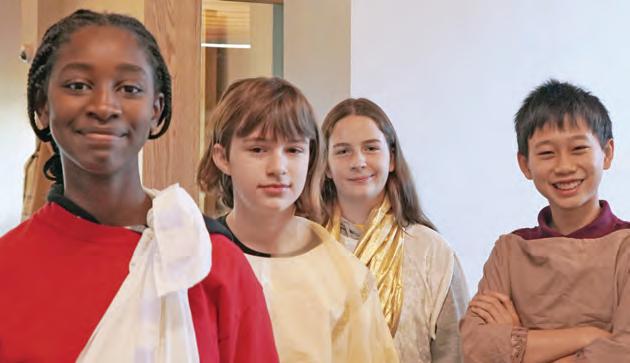
DO GRADE 7 students have sufficient life experience to tell an autobiographical story, in the manner of public radio’s “Moth Radio Hour”? The question was answered with a resounding “yes” at Storytelling Night, held in late November. Drawing from their own early years, students told tales of obstacles overcome, challenges met, chaos thwarted (or embraced), and embarrassments endured, along with the lessons learned along the way. They shared their stories with fellow students and professional-community members in the afternoon as a warm-up for the evening’s performance, attended
by parents, caregivers, and others.
The project is part of the Grade 7 humanities curriculum, which takes global citizenship as its framework.
“The theme of this unit is ‘the power of stories,’” explained Grade 7 humanities faculty member Walker Anderson, who teaches two sections of the class; the other two are taught by Eitan Tye. Students are asked to choose a story from their life to tell an audience. “The criteria,” said Anderson, “were that the story had to be true, had to have stakes, and had to be a moment in their life when some sort of change—even a small one—occurred.” R
RIVERS’ NEW DIRECTOR of alumni engagement spent 12 years at her alma mater, Wellesley College, managing alumnae and affinity programming and events to advance the college’s mission and priorities. The former psychology major says that the key to keeping graduates connected is to make sure the engagement goes in both directions. “You have to meet alums where they are,” says McKeeney.
1. YOU JOINED RIVERS AFTER MANY YEARS WORKING IN ALUMNAE ENGAGEMENT AT WELLESLEY COLLEGE. HOW DOES ENGAGEMENT WORK AT AN INDEPENDENT SCHOOL DIFFER FROM THAT OF A COLLEGE?
I think it’s more holistic. Obviously, Rivers’ population is much smaller, so you can really hone in on personal relationships, from alumni to parent alumni to faculty alumni. As a non-Rivers alum, I’m focusing on outreach and research as I acclimate to the community. I have a renewed appreciation for fundraising goals as well as the importance of building relationships across multiple sectors. It is more of a 360-degree approach.

2. WHAT DOES IT MEAN FOR ALUMS TO BE “ENGAGED”? HAS THAT CHANGED OVER THE YEARS YOU’VE BEEN INVOLVED IN THIS WORK? We used to just talk about “attend, give, volunteer.” But now engagement can be providing an internship opportunity to a student, attending an event on or off campus, serving as a class agent, opening an email, sharing a post, or just keeping a finger on the pulse and caring about what’s happening. Methods of engagement are evolving, and it is incumbent on me and Rivers to keep pace.
3. PRIOR TO WELLESLEY, YOU WORKED FOR MANY YEARS IN HUMAN RESOURCES. IS THERE A THROUGHLINE FROM THAT FIELD TO ALUMNI ENGAGEMENT?
There is definitely a throughline. These are both peoplecentric professions. You’re working with individuals from varied backgrounds and in all sorts of situations. To be successful, you must rely on your communication skills, knowledge, and empathy. When the firm where I was employed dissolved suddenly, I was unemployed for the first time in my life. The Wellesley opportunity presented itself, and I said, “I would love that job,” knowing it would allow me to use my skills and give back in an impactful way. I learned it literally from the bottom up, and it was an opportunity for me to peek behind the curtain. I had a work-study job in the same building while a student at Wellesley, and it was surreal to walk back into the building many years later as an employee.
4. HOW DO YOU BRING ALUMNI WHO AREN’T ENGAGED BACK INTO THE FOLD?
You have to listen, learn and find out what their Rivers experience was like for them. You have to inform them— or better yet, show them—how things have changed since they were students. One area of disengagement has been diversity, but we can now share the progress we’re making with affinity spaces and with the hiring of [DEI Director] Jenny Jun-lei Kravitz. You have to acknowledge their past experiences but then educate, highlight the Rivers of today, and provide encouragement and reasons to re-engage.
5. IF YOU COULD TRAVEL ANYWHERE IN THE WORLD, WHERE WOULD YOU GO?
This would be a repeat trip, but my heart is in Ireland. I feel at peace there. Australia is on my bucket list, though. So stay tuned! R
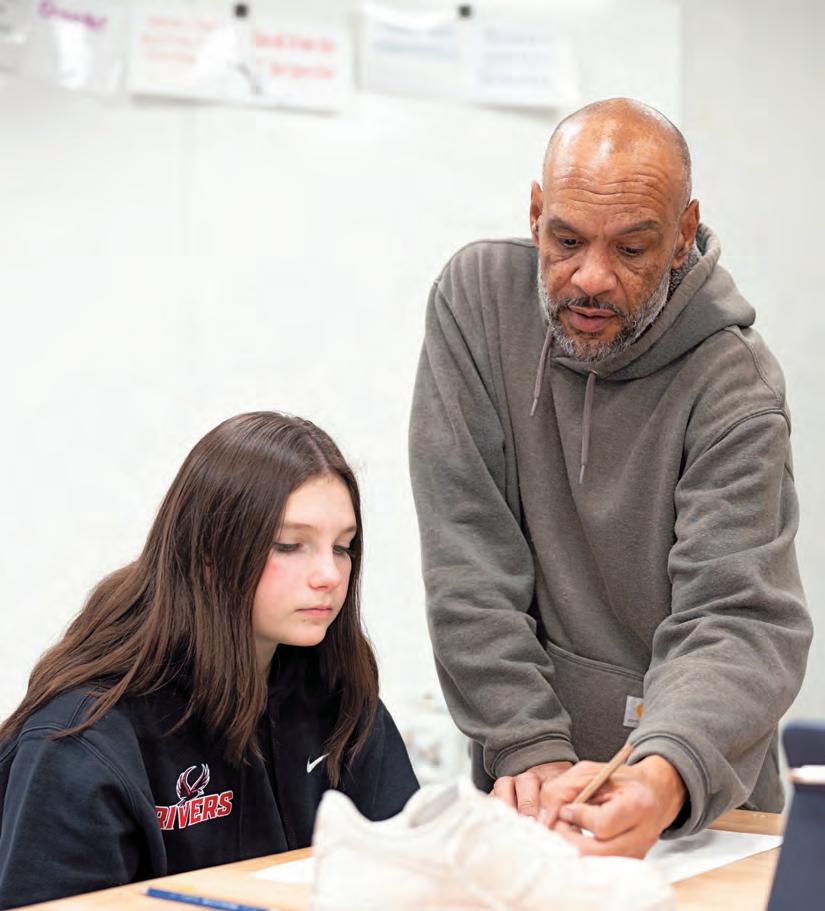
Putting Values into Practice
Chris Love P’27 has a goal for his Grade 8 students, and it’s not about acquiring skill with paint and pencils or mastering the art of portraiture.
“My hope,” says the veteran teacher, who has been at Rivers for 12 years, “is that they are seen, heard, respected, and protected.” To be sure, his students do acquire skills and create portraits, among other attainments, but for Love, eighth grade is “more about having a growth mindset. This is a place where we put values into practice, with both/and thinking and
leaning into discomfort.”
Growing up in Columbia, Maryland, a planned community that was “deliberately integrated” and where his own art instruction was “incredible and memorable,” Love himself acquired the growth mindset early on. His hometown was also, he says, “a hotbed of soccer.” He played at the University of Hartford and spent several years as a professional soccer player.
Art was always part of his life, too. Even as his soccer career took off, he says, “I always drew on the side; if I
got injured, I would draw, then go back to soccer when I was healed.” But, he says, “The older I got, the more soccer was in the rear view.” He eventually went back to school to earn a master’s degree in teaching art.
He came to Rivers in 2011 as a sabbatical fill-in and never left. Grade 8 is Love’s sweet spot; he enjoys seeing the changes—physical, intellectual, emotional—that take place over the course of this pivotal year. “The state of being in flux works in here,” he says.
Among the many mediums and projects the students tackle are journaling, portraits, graffiti, cardboard sculpture, and foundobject sculpture. Some projects tie in with other curricular areas, such as humanities. But perhaps most notable is the Grade 8 capstone project: designing a custom skateboard.
A skateboard is an intriguing canvas. But it’s also a project close to Love’s heart: As one of his two side endeavors, he works for a skateboard company, creating custom artwork. He also co-founded a consulting firm, Beyond Binaries, that works with nonprofits and schools to help them better address equity issues, racism, and oppression.
The skateboards are displayed at Grade 8 Portfolio Night in the spring, and each year, says Love, the designs are more personal, more creative, more evolved. (Some of that, he says, is due to upgrades in the physical space after the renovation of Haynes: better equipment, more room to spread out.)
Evolution, it seems, is the theme that underlies the work in this classroom. “The students are middle schoolers in the fall and upper schoolers in the spring,” says Love. “They can still tap into childhood, and we’re capturing that moment just before the swirl of high school hits.” R
“GREAT CONCERTS change the lives of listeners,” says Jake Winneg ’25, violinist in The Rivers School Conservatory’s ChamberMusicLab (CML) program. And changing lives is exactly what CML students are doing.
CML students are proving themselves to be powerful catalysts for change. Dedicated young musicians accepted into the highly selective, tuition-free chamber music program meet with their groups and coaches weekly for intensive three-hour rehearsals to dig into the nuances of their repertoire. And as part of the program, they share their passion for music in concerts both at RSC and at local community organizations. For the past two years, CML has given concerts at Hebrew SeniorLife; last year, they held another in continued partnership with Music for Food, which addresses food insecurity in collaboration with Natick’s A Place to Turn, an emergency food pantry.
CML made its home at RSC officially in 2020. Musicians Lucia May and
the late Bruce Coppock—who passed away in November 2022—founded CML to provide talented young musicians a space to give compelling performances that address important initiatives. Coppock’s legacy and his pedagogy continue to inspire students and faculty.
“Bruce was never afraid to spend an hour on a single phrase if it hadn’t yet captured the essence of the expression he felt the composer was seeking,” reflects CML Director Jason Fisher, Coppock’s successor. “He inspired me to believe deeply in the ability of young artists to seek this profound level of engagement with the music.”
CML emphasizes gaining complete mastery of a single large chamber work by taking the entire year to study all of its complexities. CML pianist Adalia Wen ’25 says, “Our passionate coaches and the amazing guest artists from CML master classes… always invite us to be more daring and vibrant, and having varied opinions always helps keep the piece fresh.”

Fisher says the community performances allow students to “impact an entirely new set of audiences, many of whom do not have access to live classical music performances.” Longtime RSC cello faculty member and CML coach Ronald Lowry adds that these opportunities create “a great symbiotic relationship between the musicians and the people in need, as the performers are now involved in these causes.”
Violinist Leah Jin ’25’s perspective on chamber music has transformed since giving community-centered performances. She says, “I learned to prioritize musicality over raw technique, because people appreciate the music itself a lot more than they notice the few notes that we may have missed.”
B y giving community-informed performances, students in CML are building up their collective voices and their communities. Students are discovering new ways of expression through taking artistic risks, leaning into the music, and performing in settings other than traditional concert halls.
Winneg added that, particularly after performing for the residents at Hebrew SeniorLife, he has gained an appreciation for how fulfilling a career in music could be. “I learned that the effect of a great and intimate chamber music performance should not be taken lightly, because you never know just how special it could be to an audience member.” R
STUDENTS IN THE ChamberMusicLab program are dedicated musicians who also engage with the community.
SONIA NAZARIO, this year’s Hall Family Speaker, says she was “born a rabble-rouser.” Her childhood nickname was “the troublemaker,” and the award-winning journalist, author, and activist still has a nose for trouble—good trouble.
On a Monday in March, Nazario held students spellbound as she recounted her exploits. In reporting jobs at the Wall Street Journal and the Los Angeles Times, she wrote stories that not only tugged at readers’ heartstrings but resulted in broad social reforms and policy changes.
Nazario’s visit tied into this year’s DEI theme of Engaging Across Differences, which focuses on examining and strengthening our community’s ability to curiously, courageously, and productively engage with those whose backgrounds, views, and experiences
are different from our own. Nazario is best known for “Enrique’s Journey,” a six-part L.A. Times series that later became a bestselling book. At her keynote speech and at afternoon sessions with Upper School and Middle School students, Nazario’s focus was on her book and the hot-button issue of immigration. “I hope to give you food for thought on the most polarizing issue in our country,” she said.

Through a chance conversation with a Guatemalan cleaning woman, Nazario found out that millions of children stay behind in Central America as their parents immigrate to the U.S. to pursue better opportunities—and that tens of thousands of
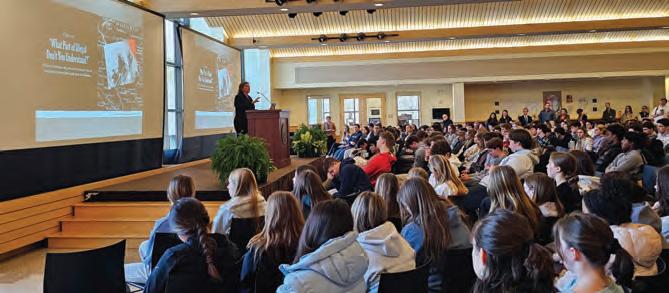

(ABOVE) SONIA NAZARIO held students spellbound as she recounted her exploits as a reporter and activist. (LEFT) Nazario, left, met Trustee Alison Hall P’19 while on campus in March.
those children brave the dangerous journey north in an effort to reunite with their parents.
Enrique was one such child, growing up in Honduras. When Nazario met him, he was a teenager who’d made eight attempts to enter the U.S. Typically, these children’s journeys involve hitching rides on the roofs of freight trains, where the travelers are beset by gangs, bandits, corrupt cops, and other perils.
Nazario decided she had to make the journey herself, and she set out from Tegucigalpa, the capital of Honduras, spending three grueling months following the path of the young would-be immigrants.
Her “Enrique’s Journey” series won a Pulitzer Prize for feature writing; it also propelled Nazario out of full-time journalism and into advocacy. Today, she is deeply involved with a nonprofit that provides legal aid to unaccompanied immigrant children. She’s testified before the Senate Foreign Relations Committee and pens opinion pieces about immigration for the New York Times
The presentation was deeply moving for students and adults alike. “Sonia’s talk was so compelling, from the most heart-wrenching details of individual migrants to her forthright ideas for immigration reform,” said Trustee Alison Hall P’19, whose support helped launch the speaker series in 2019. “I know the Equity and Engagement team did a lot of work to get students thinking about immigration before Sonia’s visit, so they were really ready to engage with her messages.” R
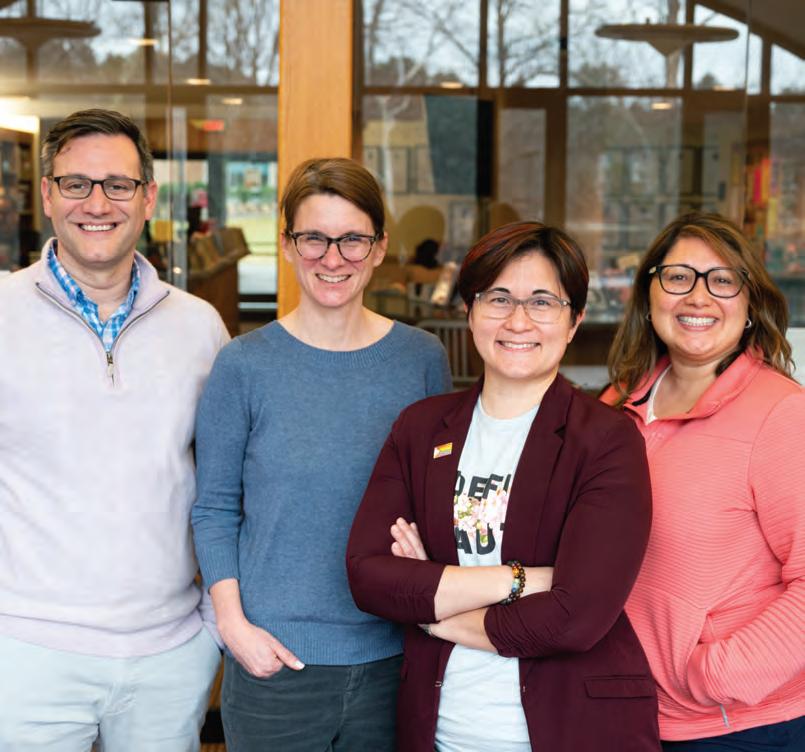
THIS YEAR, THE Equity and Engagement Department has been reorganized and expanded to oversee DEI, community engagement, and global education under new director Jenny Jun-lei Kravitz P’28— and the impact is already being felt throughout the school.
Parents and caregivers learned about the novel structure of the new team at a panel event titled “Innovation in Action” on the evening of March 6. Kravitz, along with Associate Director of DEI Katie Henderson, Director of Community Engagement Lucas Malo, and Director of Global Education Andrea Villagrán, spoke about their respective areas.
Head of School Ryan S. Dahlem introduced Kravitz, who came on board in July 2023.
“This is a really innovative structure, and it’s part of what brought me here,” Kravitz said as she took the stage.
She told the audience that the team created a mission and vision statement, landing on the goal of infusing equity, access, and belong-
ing across all areas of the school. The “belonging” piece, said Kravitz, is particularly crucial. “You want to make sure that members of the community aren’t just welcomed and seen, but also that they have agency to co-create the environment and the community.”
Each panelist explained a bit about their role and how it relates to the broader mission. Henderson handles DEI programming, overseeing areas including special presentations, affinity spaces, the cultural calendar, and bias reports. Malo, as director of community engagement, said, “My main philosophy is to get students off campus, connecting with organizations in the local area and with passions and topics that are close to their hearts.” Villagrán has overseen travel programs for several years but emphasized that, under the new structure, the school is “moving toward a more comprehensive program, away from being tourists to being active learners.”
Henderson, who served as interim DEI director during the two-year
TEAM MEMBERS (from left) Director of Community Engagement Lucas Malo, Associate Director of DEI Katie Henderson, DEI Director Jenny Jun-lei Kravitz P’28, and Director of Global Education Andrea Villagrán
search for a permanent director, said that because she continues to oversee the programmatic initiatives, Kravitz has the time and bandwidth to implement a larger strategic vision.
This year’s DEI theme, Engaging Across Differences, is a case in point, Henderson continued. The school has had a different yearly DEI theme since 2020, but this year, because of the new structure, the implementation of that theme has been more “organic and collaborative,” she said, citing such examples as a panel of Rivers professionalcommunity members who spoke about their own immigrant experiences and an impactful visit from award-winning journalist Sonia Nazario (see page 14).
Kravitz asked the panelists what most excites them about the work going forward. Malo, who joined Rivers in September, spoke about a new Grade 10 community impact fellowship planned for next year. Said Villagrán, “I’m most excited about creating a globally competency framework that’s integrated into the curriculum and isn’t just travel programs and language classes.”
“The fact that we have this structure means that they can focus on the student experience,” Kravitz said. Students are always centered in the work of the team, she added, and the new structure also enables her to bring her attention and expertise to strategic work with school leadership. “There are so many things we’re excited to do,” said Kravitz, “and we’re so lucky to be able to lean on each other throughout the day.” R
THE NONESUCH PLAYERS took over the cozy confines of the Rivers Black Box theater this fall to bring the campy, hilarious murder mystery Clue to life. Seniors Phoebe Fogel, Kam Harris, Valentina Joseph, Emerson Paquette, and Leila Saponaro were standouts, with Fogel as Mrs. Peacock, married to a senator and proud of it; Harris as the stalwart Professor Plum; Joseph exuding hauteur as Mrs. White; Paquette as the crafty butler Wadsworth (spoiler alert: the butler didn’t do it); and Saponaro as Miss Scarlet, a lady in red. (And yes, someone does say, “Frankly, Miss

Scarlet, I don’t give a damn.”)
The clever set consisting of wall dividers and wheels allowed for action and plot twists to unfold across multiple rooms. Student crew and faculty members including director Juliet Bailey, producer Julia Auster-
Hogan, costume designer Cathy Favreau, and light board operator Walker Anderson supported the ensemble drama, and all involved clearly enjoyed coming together to put on a fun show, with an affectionate nod to the classic board game. R
Middle School Performs an Intriguing New Adaptation of The Legend of Sleepy Hollow
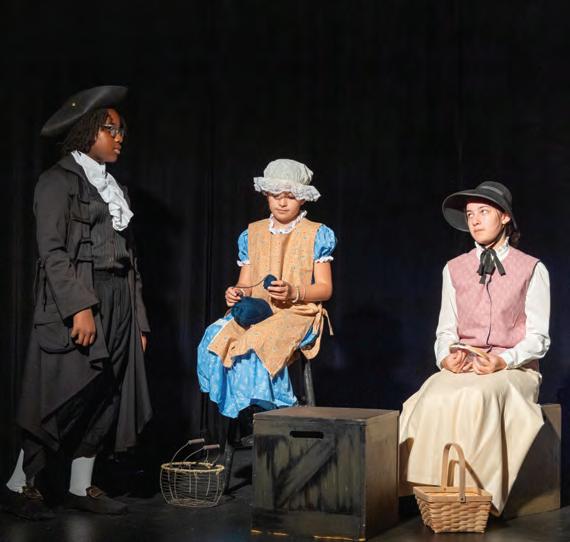
THE MIDDLE SCHOOL’S fall production of The Legend of Sleepy Hollow, in a new adaptation by director Ellie Strayer, put a sweet spin on this familiar classic in Rivers’ Black Box Theater. As in the original, which claims to be “inspired by the found papers of the late Dietrich Knickerbocker,” this adaptation is a story within a story. Led by a narrator embodying the voice of Washington Irving, the production began with hand-shadow puppets recreating the familiar legend of the Headless Horseman and the schoolteacher Ichabod Crane. Ichabod is spurned by his crush, Katrina Van Tassel, and run out of town by a Headless Horseman. But there’s a twist: Our narrator then claims that this familiar tale is an absurdity concocted to cover the truth—a truth that includes pumpkins, parties, petrified residents, and murder.
The show’s conclusion provided a few lessons: Don’t get too attached to your position in society; gossip is fun but bad; don’t steal (or at least, don’t make it obvious); be cautious around sleeping potions; and overcome your fears. Historical costumes by Cathy Favreau and a suspenseful soundtrack operated by producer Julia Auster-Hogan added texture to this entertaining and spooky production. R

IF YOU ATTEND a Rivers varsity game, you might catch a few students on the sidelines, moving quickly to capture the action of the athletes in photos and video. With a hand in everything from photography, videography, and graphic design to video production and editing, these students—participants in the Rivers Athletics Internship Program—bring the excitement of the games to thousands of followers on the athletics social media channels and earn a sports credit at the same time.
Jacob Werrick ’16, assistant director of athletics, developed the program, now in its third full year, while balancing coaching teams and building a following on the athletics social media platforms. The first cohort started small, with borrowed cameras, and has now grown to an official program unique among ISL peer schools, with professional gear and space for interested students to gain practical experience with sports media. The application process is by sports season (fall, winter, spring) and has become increasingly competitive.
Werrick, who mentors the students in the program, says the group takes inspiration from teams at the collegiate and professional levels to develop content for Rivers’ social media channels. Cohorts meet once a week to determine media coverage for each of the games, receive student-led production-software training, and hear from guest speakers in the industry. Their final projects, a new component this year, included creating sportsspecific websites, making videos, and tracking in-depth game statistics.
Evan Deede ’24, an intern since the first year of the program, has served as a mentor for the newer students and is planning a career in sports media.
“I’ve learned a lot with Premiere Pro [one of the industry’s leading video



editing programs], which has helped me to elevate my work,” said Deede, who specializes in video production. “It’s all about learning what works and what doesn’t and figuring out skills on your own.”
With students creating content for their peers, the athletics channels have been able to make closer and more authentic connections with their audience. Harper Fruhan ’24, another intern from the beginning, creates content for the TikTok channel and has also watched the evolution of the
internship program. “School spirit has really elevated since we’ve been involved,” she said. “As teenagers in high school, we know what teenagers in high school are looking for.”
Part of what makes watching or playing sports exciting is the unpredictability. The world of sports media mirrors that energy, and Rivers interns are gaining valuable experience in that world, quickly responding and adapting to changing trends and technologies and bringing audiences along for the ride. R
How this “small but mighty” group of professional-community members oversaw the first phase of Rivers’ 10-year accreditation cycle

THE LAST DAY BEFORE the December break is typically a pause point at any school. Students have left the building, buzzing in anticipation of the vacation ahead. Teachers are thrilled to have made it to the finish line; administrators are heaving a sigh of relief that all has gone well and everyone is about to disperse.
But at The Rivers School on December 15, 2023, that transition felt a little different. A full professional development day was devoted to sitting down and writing rough drafts of a self-study, comprising 13 program reports, for the school’s accreditation by the Association of Independent Schools in New England (AISNE), scheduled to be completed this spring. Each program report is tied to a “standard” that covers an area of school operations, ranging from mission and philosophy to student well-being to facilities. (See sidebar, page 23.)
Nearly every member of the professional community participated in the yearlong self-study, which serves as the first phase of the accreditation process.
The team running the self-study—the “AISNE Five,” as it were—had announced the schedule before the start of the school year. They realized it was asking a lot of the professional community to have them work on this phase of the project on the last day of the term.
BY CATHERINE O’NEILL GRACE PHOTOGRAPHY BY KRISTIE RAE DEANBut the Rivers faculty and staff threw themselves into the task. “The professional community has
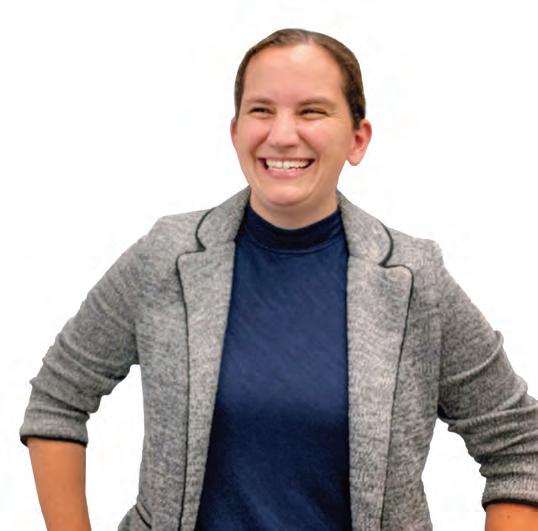



(CLOCKWISE FROM UPPER LEFT) English faculty member Mary Mertsch P’27, ’29, former faculty member and curriculum consultant Melissa Dolan ’98, science faculty member Sequoyah Reynoso, director of leadership and planned giving Meret Nahas, and English Department chair Mac Caplan stepped up to oversee the AISNE self-study, the first phase of the accreditation process.

THE PROGRAM REPORTS that make up the AISNE self-study delve deeply into nearly every facet of the institution. These examples from two of the reports (still a work in progress at this writing) give a sense of the type of questions addressed.
This excerpt from the English Department’s report responds to the question, “What directions and priorities are envisioned for the future of the program?”
The department needs to lean fully into contending with the opportunities and challenges posed by generative AI. We need to approach with urgency the imperative to understand how learning—and writing, in particular—needs to evolve as a result of this new technology.
Moreover, the department would like to identify meaningful data points to learn about what skills are most necessary for college preparation in the contemporary world. We would like to gain insights from alumni about their college and early professional experiences, and we hope to connect with collegelevel instructors to understand how we can best prepare Rivers graduates for their next steps.
Another example, this one from the Middle School report, addresses a question about how the program aligns with Rivers’ diversity, equity, and inclusion mission:
Curricular experiences are designed with the aim of turning knowledge into action, both within and beyond the classroom spaces. The humanities mission states that “When students leave the humanities program, they will do so with a deeper understanding of themselves as individuals, community members, empathic citizens, and agents of change.” Recent humanities teaching team conversations have raised questions around determining the extent of effectiveness of these efforts as well as identifying additional methods for encouraging students to confront injustice when they see it, even in the context of peer pressures and other influences. These examples capture the depth and detail of the program reports drafted the day before winter break in December 2023. The program reports were revised and completed this spring, and the final document will be shared with AISNE before the visiting team comes to campus this fall.
been remarkably dedicated to the self-study,” says Head of School Ryan S. Dahlem. “It was the last day before break, yet people were there, motivated and engaged, and produced some amazing work. There was something special about starting in the morning with a blank Google doc and having 200 pages of content written by the end of the day.”
Accreditation is a voluntary two-year exercise that independent schools go through every 10 years to ensure they are meeting a certain set of standards in all aspects of their operations, including mission, educational programs, governance practices, student life, finances, and more. In the first year, the self-study generates a comprehensive report that the school shares with AISNE.
In the second year, the school hosts a team of peers from other AISNE schools for a three-day campus visit. The team conducts an on-site evaluation to validate the self-study findings, gather additional information, and engage with the school community. They then prepare a report that includes their findings, commendations of strengths, and recommendations for improvement.
The self-study is at the heart of the process. The undertaking offers an opportunity for the whole school to engage deeply in institutional reflection and goal-setting through the lens of mission.
It was clear early on that the massive project would need a nimble and dedicated group to oversee it. In winter 2022, former Head of School Ned Parsons put together a fiveperson team of volunteer leaders: Mac Caplan, the English Department chair; Melissa Dolan ’98, former
“ I love the quantitative and the qualitative nature of the data. I’m grateful that our team has included this research as an important part of our process.”
—HEAD OF SCHOOL RYAN S. DAHLEM
faculty member and curriculum consultant; Mary Mertsch P’27, ’29, English teacher and director of new faculty development; Meret Nahas, director of leadership and planned giving; and Sequoyah Reynoso, Upper School science teacher. “We were selected by Ned, and with Melissa and [Head of Middle School] John Bower, they designed the committee structure of two co-chairs and three others who are responsible for aspects of the different sections,” says Caplan, who co-chairs the group with Dolan. Among the five, knowledge of Rivers runs both broad and deep. As Nahas said when introducing the leadership to the Rivers community at a kickoff meeting, “The AISNE Committee is a small but mighty group.”
They would certainly need to be mighty. Coordinating the data gathering, writing, and editing for the report takes organization, skill, diplomacy, and a lot of extra hours. But, Dolan says, “Rivers has invested in this being a successful process. It’s been awesome to have a team with five people coming from different parts of the school or different perspectives on the school—veterans and newer community members, Upper and Middle School, and development. I’ve gotten a lot out of the collaboration, and it’s also a reminder about what it takes for a school to function, all the stuff that’s happening, often behind the scenes. We get to ask, ‘How do we pull this off every day?’”
The self-study process has given Caplan, who has been at Rivers since
2005, a new appreciation for the complexity and interconnectedness of the institution, he says.
“What we do at a school is primarily about what’s happening in the classroom between the student and the teacher,” he says. “But there’s just so much more that goes into enabling that—whether it’s providing the right resources and facilities, or the fundraising that has to happen to generate those resources, or the enrollment management side that informs and ultimately determines who is in the classroom. Through the self-study, I’m seeing all the things that go into my being able to walk into a classroom and work with students in the way that I’m so lucky to be able to do.”
Managing and participating in the multiple moving parts of the self-study
has been a huge time commitment, but it’s well worth the effort, says veteran faculty member Mertsch. “Accreditation is a chance for us to take a look at ourselves in the mirror, think about where we’ve been and who we want to be, and be a part of conversations about that,” she says. “I think it’s really exciting.”
Nahas adds, “I am going on my second year at Rivers. I thought that [serving on the AISNE Committee] would be a good opportunity for me to really look under the hood and learn more about the school, especially in my role with a lot of external constituents. It gives me a better sense of who and what Rivers is from a really authentic place. I’m learning so much working through the drafts of the self-study and being able to work with colleagues that I wouldn’t necessarily connect with otherwise. It’s been one of the most fulfilling things that I’ve found at the school so far.”
Seeing the big picture appealed to Reynoso, too. “I’m a science teacher,” he says. “I wanted to do this because I was really curious about how the back end of the school works. I’ve seen the

THE AISNE SELF-STUDY is one of several factors that will influence the creation of the school’s new strategic plan, which will be finalized next spring.
perspective of my own department. But I didn’t know a lot about administration or governance.”
Rivers launched its self-study in summer 2023. First drafts of the 13 program reports were composed at the December 15 meeting, followed by ongoing review and editing by the AISNE Committee. To keep the process on the boil, the group has convened every Wednesday throughout the school year, editing the first round of reports and returning them to committees for revision. Cochairs Caplan and Dolan sit down with Dahlem every other week to keep him informed.
The 10-year accreditation cycle coincided with a pivotal time in the life of Rivers: Dahlem took up his position as new head of school just as the process got underway.
“In a year where one of Ryan’s main priorities is to learn a lot about the school, the self-study itself becomes an indispensable document for him,” says Caplan. “The process is a really informative way for him to learn about the institution. When he arrived, he put a big question before the committee: ‘What’s next for Rivers?’
The self-study is going to provide a set of answers.”
“Having the self-study line up with my arrival at Rivers is incredibly helpful,” says Dahlem. “I’m coming

in, learning a lot about the school, and asking a lot of questions. And by its nature, accreditation is exactly the same process happening institutionwide. It’s a large-scale opportunity for institutional reflection, taking stock of where we are, what are our strengths, what are opportunities for growth, and what action steps do we envision for the future?”
Dahlem isn’t surprised by the Rivers professional community’s willingness to engage in the extra work a self-study demands. “They care so much about our students, about their craft, about Rivers as an institution and how to make it even better,” he says. “The word ‘accreditation’ is not the most inspiring word, so I framed this in an elevated way of beginning to design the future of our school.”
By involving every member of the school in some aspect of reflection on their roles, the self-study examines how Rivers measures up to the standards set by AISNE. “We’re trying to connect people across departments and divisions and roles,” says Dolan. “We’ve viewed it as a product and a process—and the process is a community-strengthening one.”
“The way we’ve approached this is different from what other schools do, in that the committees are composed of a real cross-section of people in the professional community,” Caplan notes. “People are not on committees for areas that they oversee or work on. For instance, the enrollment management and outreach committee doesn’t have members of the admission office.”
Creating the program reports called for both analysis of data and deep reflection. Among the questions
THE AISNE COMMITTEE met weekly throughout the school year to work on the self-study.
Each committee was assigned a “standard” for which to create a program report. The AISNE process asks the school to examine and report on these standards:
LEADERSHIP
MISSION AND PHILOSOPHY
GOVERNANCE
ADMINISTRATION
STUDENT EXPERIENCE/PROGRAM
CURRICULUM & STUDENT LIFE
STUDENT WELL-BEING
PROGRAM RESOURCES
INSTITUTIONAL ADVANCEMENT & OPERATIONS
ENROLLMENT MANAGEMENT/OUTREACH
COMMUNITY ENGAGEMENT
DEVELOPMENT
STAFFING/HUMAN RESOURCES
FINANCE
FACILITIES
SAFETY & RISK MANAGEMENT
Additionally, each academic department, as well as athletics, college counseling, and The Rivers School Conservatory, is writing a report on its operations and aspirations.
addressed: How does the program align with the mission of the school? How does it align with the school’s diversity, equity, and inclusion goals? Does it reflect the core values of “Integritas et Sedulitas” and the school’s philosophy of Excellence with Humanity? What are the program’s major strengths and its opportunities for growth? What is the vision for the direction and priorities of the program in the future?
As part of the self-study, an accreditation data team has gathered extensive quantitative information through surveys and focus groups with students, the professional community, parents, caregivers, and alumni.
“I love the quantitative and the qualitative nature of the data, and the texture that emerges from focus groups. I’m grateful that our team has included this research as an i mportant part of our process,” says Dahlem. He sees the self-study as essential fodder for envisioning the future of The Rivers School, in concert with a market research study, a mission and core values review, and a campus master planning exercise now underway.
“The work ahead will be to synthesize all of this information,” he says. “It will springboard us forward in terms of the design, creation, and implementation of our strategic plan. It’s going to launch us into our future.” R
Catherine O’Neill Grace, a freelance writer, was formerly the editor of Independent School magazine at the National Association of Independent Schools.



VISITING ARTIST JOAN HALL (LEFT) spoke with students about her work during her visit to campus earlier this year.
Nicole Winters launched the visiting artist program at Rivers in 2020, she had “a vision.”
In addition to her teaching duties, Winters had taken on the role of gallery coordinator at Rivers, following the retirement of longtime faculty member Jeremy Harrison P’05, ’07, ’07, ’11, ’13. “I thought it would be fun,” says Winters. “I’ve always been interested in that aspect of the art world— not just making art but looking at art and learning about artists.”
With the opening of The Revers Center for Science and Visual Arts in January 2020, the school’s space for exhibiting art increased dramatically to include not just the Bell Gallery on the lower level of the Campus Center but the Baldwin Family Art Commons in the lobby of the new building. That was part of what inspired Winters to expand the mission of the galleries: “I thought of making them more of a space for learning, beyond just looking at student artwork.”
In graduate school, Winters continues, she was engaged by the Harvard Graduate School of Education Project Zero’s Artful Thinking program, which employs “visual tuning strategies” to strengthen student learning across the curriculum. “I loved doing that,” she says, “and I thought that could be something I could bring to the gallery spaces, with room to bring outside artists in.”
She proposed the idea to then department chair David Saul and worked with him—and later with current chair Tim Clark P’29—to quickly plan an exhibit featuring works by artist Naoe Suzuki for the late fall of 2020. “That first one was a last-minute thing,” Winters recalls, but the idea was that Suzuki would also spend time on campus interacting with students, visiting classes, and presenting talks—in short, serving as a visiting artist, such as might be found on a college or art school campus.
Winters explains, “When I started conceiving of the artist program, I thought it would be akin to a residency, where an artist would come to campus and make work and be provided with a studio and teach workshops—a very immersive experience.”
COVID, of course, had other ideas, but that didn’t stop the visit from proceeding, albeit in modified form. Suzuki did come to campus in person in October 2020 to install her work, but her classroom visit and artist’s talk during an allschool meeting took place virtually.
It might have seemed an inauspicious start, but Winters was undaunted, and since then the Visiting Artist Program has taken root as an annual and much-anticipated event. Each year, the exact programming to support the artists varies a bit, as each artist brings a different perspective and approach. But the visits invariably leave the campus
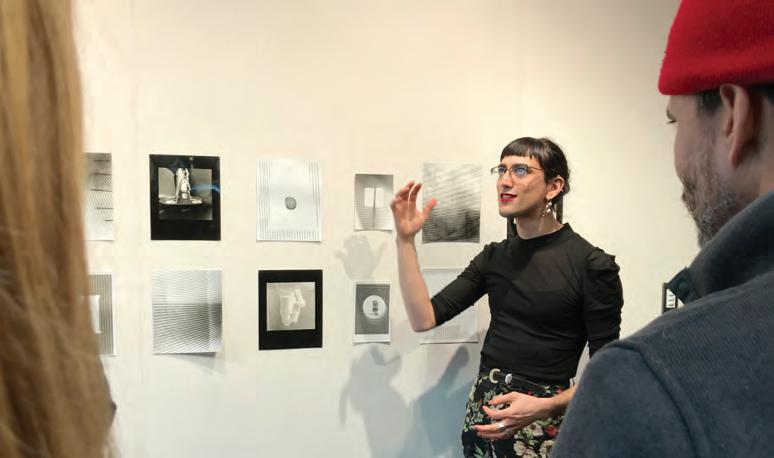
enriched, as the artists engage, share their practice, and spark dialogue.
Winters chose Suzuki to inaugurate the series partly because her work—like The Revers Center itself—stands at the intersection of art and science. “I thought she might be an interesting first artist for this building,” says Winters. Suzuki had held a residency at the Broad Institute, the Cambridge biomedical and genomic research center run by MIT and Harvard, a few years earlier, and some of the artwork
that grew out of that experience was displayed at Rivers.
That work also resonated during the pandemic, Winters continues. “It was a time when we were so unsure, and when science was so important to us; her process really connected to themes we were all feeling.”
Subsequent visiting artists have also reflected societal concerns of the moment. “That continued to be a goal— to find artists that speak to different larger issues or themes present in our
school,” says Winters. “I wanted to be thoughtful about the artists we bring here. I wanted it to be about more than just pretty pictures; I wanted the work to speak to our community.”
The following year, at a time when our nation and its institutions were undergoing a racial reckoning following the murder of George Floyd, the visiting artist was Cedric Douglas, whose work addresses such themes as social justice and police brutality. He is best known for his public murals

and installations, but at Rivers, he exhibited his Street Memorials Project, commemorating the lives of Black people lost to police brutality. The multimedia, multifaceted work spurred thoughtful conversation on campus.
Last year, the nonbinary artist Opal Ecker DeRuvo raised questions about gender and representation through their work and campus visits. “Representing that in our community felt important,” says Winters.
This year’s visiting artist, Joan Hall, draws much of her inspiration from the ocean—its beauty, its fragility, and the environmental threats it faces. “We have salt in our blood, in our sweat, in our tears. We are tied to the ocean,” Hall told the audience at an Upper School assembly, quoting John F. Kennedy. Hall’s work begins in printmaking, but she takes the prints— most of them on paper she makes by hand—in unexpected directions, building them into massive, intricate three-dimensional pieces that sprawl over gallery walls or colonize swaths of floor space. They incorporate multiple layers of prints laminated with mylar and acrylic, along with bits of plastic detritus scavenged from the ocean, glass beads, and other found or created elements. Hall’s oversized works bear
“ I ’VE ALWAYS BEEN INTERESTED IN THAT ASPECT OF THE ART W ORLD—NOT JUST MAKING ART BUT LOOKING AT ART AND L EARNING ABOUT ARTISTS.”
—NICOLE WINTERS, VISUAL ARTS FACULTY MEMBER
such titles as Acid Ocean, Incoming Tide, and On the Reef, reflecting her focus.
Today, of course, any conversation about the ocean leads to the topics of pollution and climate change, and Hall wove that into her visit. The artist addressed the AP Environmental Science class as well as a printmaking class.
Identifying and engaging a visiting artist takes many months of thought and planning; the process for choosing next year’s guest was just getting underway in March. Winters wasn’t yet sure what sort of theme she would pursue, but she said that “for this upcoming year, I’m looking for either a photographer or a sculptor—I want to h ave a different medium represented.”
She notes that it’s a big commitment on the part of the artist: filling two large galleries, giving a talk, working with a class or two, perhaps appearing at a reception. Hanging or installing the show also makes demands on the artist’s time. “It always takes longer than you think,” says Winters, noting that hanging Hall’s large-scale works took three full days.
But the rewards more than justify the effort. Winters says a colleague recently remarked that “a lot of students don’t get exposed to art in their daily lives. They might not be going to museums or galleries regularly. Bringing real artists to our school broadens their understanding of what art can be and what art is for.” R

NAOE SUZUKI, THE inaugural artist in the series, worked within the restrictions of the pandemic to bring her art to campus.
CONDUCTING RESEARCH on fetal alcohol syndrome at one of Boston’s leading hospitals. Performing gel electrophoresis at a state-of-the art lab in the Longwood Medical Area. Developing software at a local engineering firm. Debating the bioethical implications of using CRISPR technology to address sickle cell disease at a meeting of Harvard Medical School’s Community Ethics Committee. Diagnosing and treating a “patient” who happens to be a hightech mannequin, similar to those used to train aspiring doctors.
These are just some of the extraordinary opportunities The Rivers School offers students who want hands-on experiences in science. Science Department chair Betty Bloch says the department’s philosophy supports and fosters this kind of experiential approach. “Students have the opportunity to delve into authentic scientific inquiry, tackling complex problems and conducting experiments under the guidance of mentors,” says Bloch. “This immersive experience not only enhances their knowledge of scientific principles but also cultivates the critical thinking, problemsolving, collaboration, and communication skills essential for success in both academic and professional settings.”
This past winter, Bloch oversaw the launch of a new independent research program (see page 30), providing a particularly robust experience for advanced students. “Participating in research at the high school level provides students with an invaluable opportunity to explore myriad disciplines, ranging from bioinformatics to cancer biology to fly genetics,” says Bloch. “By engaging in such research endeavors, students not only gain a deeper understanding of their interests but also establish meaningful connections within the scientific community, setting a solid foundation for their future endeavors.”
Why is hands-on work particularly important to the study of science?
Bloch says the students “learn to think like scientists—formulating hypotheses, designing experiments, analyzing data, and drawing conclusions based on evidence.”
Bloch notes that this is “an exciting time to be on the second floor of Revers,” where new science labs and classrooms came online when the building opened its doors in January 2020. The independent research program for seniors is in the pilot phase; starting in the fall of 2024, says Bloch, a new Grade 10 STEM seminar is designed to “provide exposure to a project-based curriculum in coding, 3D modeling and design, computer science, and computational thinking.” These seminars and experiences show students what it means to be a scientist today and teach them skills they’ll need as they pursue careers in a variety of fields.
But to science faculty member Nick Herrmann, there may be an even more compelling benefit to applying classroom knowledge in real-world settings. “One of my greatest hopes as an educator is that kids will leave here with a love of learning and curiosity,” he says. “We want them to have the skills, but if they don’t have curiosity, they won’t be lifelong learners. Giving kids an experience that is exciting and engaging is one of the best things we can do to ensure they’ll continue to grow once they leave here.”
Building Skills, Sparking Curiosity
WHEN THE REVERS Center for Science and Visual Arts opened in January 2020, it unlocked a range of opportunities for students. One was the chance to be exposed to the practice of original scientific research, utilizing the labs and equipment available in the new building.
But the inspiration for Rivers’ newest hands-on science program also came from the students themselves. “Three years ago, my first year here, there were three senior girls who wanted to do research on how resistance forms in E. coli,” says Science Department chair Betty Bloch. “We read literature, we did experiments, and we analyzed the data. It was a lot of work, and it was driven by these three girls who wanted to go into science.”
That experience made Bloch and her colleagues think about creating a more formal program for student research. Thus was born Advanced Topics in Life Sciences Research, a two-year program students can apply to join in the fall of their junior year. These students spend the second half of Grade 11 in the intensive program, learning how to read scientific studies, plan an experiment, and master basic life-sciences lab skills for an independent research project. Students who participate in the Grade 11 program are eligible to apply for Grade 12 research projects, pursued in coordination with science faculty member Sequoyah Reynoso.
Current juniors are taking part in the program’s pilot this year. Fourteen students have been meeting twice weekly, arriving before school for early-morning sessions, since December. And over March break, they spent four days in a “deep dive,” honing their lab skills at the Harvard Medical School MEDscience program.
If the students had any reluctance about giving up four precious vacation days, it wasn’t evident. Spirits were high on a Tuesday in March when the van, driven by Bloch, pulled away from Rivers at 8:00 a.m.
Watching the students performing gel electrophoresis in the lab later that morning, Bloch noted that this self-selected group is passionate about science. “They’re looking for rigor and meaningful experiences, getting more of a taste of what college will be like,” she said.
Reynoso says that his goal for students in the program is threefold: that they learn how to read research articles, get a general feel for the techniques and planning of research, and, most aspirationally, perhaps
contribute to original research and publish a paper. That might not happen for years, says Reynoso, who holds a Ph.D. in neuroscience, but it’s a distinct possibility.
Bloch, who earned her doctorate in biochemistry, notes that research can sometimes end in disappointment: “I spent three years in grad school on a project. At the end of the third year, I found out that half of it wouldn’t work and half was already published.”
But for these Rivers scientistsin-training, that wouldn’t be a bad outcome. “That experience is pretty common,” says Reynoso. “You might not be able to use the data, but the skills and the grit are important. You almost wish for that. A lot of the great discoveries were serendipitous.”

AS PART OF their preparation for next year’s independent research projects, a group of juniors traveled to the Harvard MEDscience program over March break to work on their lab skills.
THE SUMMER SCIENCE internships, a signature Rivers program for rising seniors, send students into a variety of settings— medical, engineering, software, biosciences, robotics, and more—to gain substantive experience in those fields and see firsthand what a career in sciences can look like.
“The original and still most important goal of the program is to get kids into real labs, real businesses, real doctors’ offices and hospitals, doing real work,” says science faculty member Michael Schlenker P’26, who oversees the program.
Applicants to the selective program submit material over the winter, including a cover letter and essay detailing their interests and their reasons for pursuing an internship. Once they’ve cleared that hurdle, they must sit for an interview with Schlenker. That process helps set the stage for the internship, letting students know that they will be working in professional, demanding settings and will be expected to comport themselves accordingly. Schlenker also uses the application process to help match students to internships; for the most part, students are placed in areas that reflect their interests.
Come fall, the summer science interns make presentations to the Rivers community about their experiences—a required element of the program. Students must also write a lengthy blog post reporting on their internships.
The final presentations are brief, of necessity, but students have sufficient time to share what they’ve learned and convey their excitement about their summer placements. “On presentation day, it’s great to see the other students support the interns, as it’s a




SUMMER SCIENCE internships take students into a variety of professional settings, from doctors’ offices to labs to software companies.
culmination of a process that started almost a year ago,” says Schlenker. “I’m so impressed with how each intern summarized and presented such complex science—in under three minutes.”
Rivers has offered the Summer Science Internships for more than two decades. But the program has expanded greatly over the past few years, thanks in large part to financial support from donors Kena and Michael Thompson P’22, Mark Klett ’71, Chris Ehrlich ’88, and Jeff and Connie Walsh P’20, ’26, which allows participating students to receive stipends. “That has really helped the program,” says Schlenker. “If kids are deciding between ‘I have to make money’ and ‘I want to do the internship program’—now, they don’t have to make that choice.”
Students experience many firsts in the course of their internships, but Schlenker says the new experiences begin long before the summer placements. “The internship program is important because it’s often the students’ first experience applying to and working in a professional science setting,” says Schlenker. And, he adds, a successful outcome can be measured in many ways. A student may discover that, say, they want to pursue a programming career—or they may learn that programming is not for them. “Both of those are positive experiences,” says Schlenker.

THE PATIENT HAD the medical team stumped. Jeannie was a 22-yearold college student complaining of fatigue and stomach pain. She seemed generally healthy, and though she occasionally drank to excess, her liver panel and other test results were mostly normal.
Also: She was made of plastic and wore a bright-blue wig.
“Jeannie” is a high-tech mannequin used for simulating various medical situations and procedures, and the medical team, clad in scrubs and carefully reviewing the case at each step, was a group of Rivers seniors enrolled in the Anatomy and Physiology elective. The students were participating in their last session at the Harvard Medical School MEDscience program; several times throughout the semester, they had traveled to the medical school to participate in hands-on classes taught by doctors and other medical
professionals. At the heart of each session was the opportunity to work on a simulated patient, and at this point in the semester, they had performed an intubation, learned to take vital signs, inserted an IV, and diagnosed and treated an asthma attack, a heart attack, and T ype 1 diabetes.
Rivers has participated in the program for many years. This year, Nick Herrmann, a science faculty member since 2021, taught the class for the first time. The rigorous coursework, which takes students through the respiratory, endocrine, cardiovascular, digestive, and nervous systems, is complemented by the MEDscience sessions, where students put what they’ve learned to use and get a glimpse of what it might be like to work as a physician or other medical professional.
On six Tuesdays throughout the semester, the students traveled to the
STUDENTS IN the anatomy and physiology elective visit the Harvard MEDscience program weekly throughout the fall semester, getting handson experience in diagnosing and treating symptoms.
Longwood Medical Area. Not only did the students master some of the basics of medical treatment, says Herrmann, they learned how to put such treatments, and the patients who receive them, in context. “The students look at social determinants of health—at the role played by gender, economic status, race, and other factors in determining an individual’s potential medical risks and access to health resources,” he says. Weekly written reflections encourage students to see the full picture of patient care and not simply the biology behind medical situations.
In the simulation lab, the students’ first step was to gather a patient history, which they did with the aplomb of professionals. They elicited Jeannie’s family history, details about her lifestyle, and additional information about her symptoms, but a diagnosis remained elusive.
A fter a few rounds of tests, they hit on the solution: Jeannie showed a ll the signs of opioid addiction. They then swung into action as Jeannie seemed to lose consciousness after a potential overdose, administering CPR and naloxone to counteract the drug’s effects.
A short graduation ceremony capped off this final session, with each student receiving a certificate of completion and sharing a few words about the impact of the program. Taylor Parsons ’24 may have spoken for the entire group when she said, “This really opened my eyes. I really loved learning about the practice of medicine.”
Messy, Complicated—and Meaningful
“WHOSE ETHICS matters?”
The question posed by the woman on a Zoom in a Revers Center classroom wasn’t simply rhetorical. The students—all participants in the Special Program in Bioethics— had been grappling with the issue and others like it all year, and the virtual visitor, Lori Bruce of the Interdisciplinary Center for Bioethics at Yale, was one of several guest speakers who addressed the group as they tried to find clarity around the complicated topics facing bioethicists.
Clarity—but not too much clarity. Bruce said she loves that in bioethics “everything is always wrong. It’s messy and complicated and it’s all about compromise and working with others.” That very complexity, she said, is part of what keeps her engaged in the work.
It’s also what draws in Rivers students. The bioethics program occupies an unusual niche, somewhere between a club and a class. The group of juniors meets once a week throughout the school year, and students receive half of one academic credit, which counts toward fulfilling their interdisciplinary studies (IDS) requirement. Participants pursue the program on top of their regular course load, simply because they have a particular interest in the subject matter.
Each student must produce an independent research project that delves deeply into the topic of their choice—one that addresses a realworld challenge. A goal of the program, says its faculty leader, IDS Department Chair Julian Willard P’24, is to get students out of the “school bubble.”
“It’s about making a difference and engaging people beyond our community in questions that really matter,” he says. Toward that end, two
times during the year the students attend meetings of the Community Ethics Committee, an arm of Harvard Medical School’s Center for Bioethics. The committee is composed of members of the greater Boston community who meet regularly to provide input on ethical aspects of health care; their reports have frequently resulted in policy changes at Harvard-affiliated hospitals. At the spring meeting, in April, the students presented their projects to the committee; the projects were also presented on campus at an Upper School assembly that month.
In the virtual meeting with Bruce, students shared their project topics: the bioethical implications of using CRISPR technology to address sickle cell disease; preventive care for homeless patients;

xenotransplantation. “All hot topics,” said Bruce approvingly.
Bruce concluded her visit by inviting the students to come to New Haven for a few days to sit in on the Summer Institute in Bioethics she runs at Yale. Given Willard’s stated goal for the program, it would be a fitting conclusion. By year’s end, says Willard, he hopes that “we’ve burst the school bubble a little. I believe they understand the bubble around high school is much more permeable than they had realized. Their discussions have a direct impact on the Bostonarea community. My hope and belief is that they are not the same at the end of the year. They know they are part not just of the Rivers community, but also of Massachusetts and the U.S. and the world community, where their voices matter.” R


IN THE BIOETHICS program, students meet weekly to tackle challenging issues in the emerging field.

The Powerful Woman Behind the Prize
EACH YEAR AT PRIZE DAY, two faculty members receive the Mida van Zuylen Dunn Award for Teaching. Attendees are told that the award is “given yearly to two teachers who, through the caring and practice of their craft, instill in students a love for learning” and that it was established in 1996 with a gift from Mida van Zuylen Dunn P’70, ’76, a former Rivers teacher, assistant librarian, and parent of two alumni. Dunne added a second fund in 2007 to support the award, which provides a stipend for each recipient.
What those in the Prize Day crowd don’t learn is the story of the remarkable woman behind the annual prize. Madame Dunn, as she was universally known, embodied the phrase “a force to be reckoned with,” say those who knew her. Dunn, who was the first female teacher at Rivers and who passed away in 2011, would have turned 100 this year. She touched the lives of hundreds of students and left a lasting impact on the institution that still honors her memory with the yearly prize she generously established in 1996.
“Mida was a very, very strong woman,” says former faculty member Jack Jarzavek, who worked with Dunn for many years. Indeed, Dunn
arrived at Rivers thanks to a gap left in the teaching staff when Jarzavek moved from the French Department to the English Department. Dunn, a native French speaker who grew up in Belgium, was hired to step into the breach.
“ I never knew a time my mother wasn’t working,” recalls her daughter, Jacqueline Dunn. Unusually for a woman of her generation, Mida Dunn finished college and forged a career, while raising three children.
Born in what was then the Belgian Congo, Dunn spent World War II in Brussels. “If there’s one thing my mother was, it was a survivor,” says Jacqueline. “She survived the war in Brussels”—a challenging time when the country was occupied by Germany and endured rationing, bombing, and worse.
But the young woman was determined not just to survive but to thrive. At Dunn’s 2012 memorial service at Rivers, Jarzavek recounted a story she’d told him about her early year: “She decided she wanted to go to college, and her father or mother had her go see the local parish priest, who tried to talk her out of it. But she was adamant, and the priest ultimately threw up his hands and said, ‘The sin is in you!’ ”
Not to be denied, Mida made her way to the U.S. after the war, marrying John F. Dunn in 1950. She had three children: John-Peter ’70, Jacqueline (Walnut Hill School ’72), and Christopher ’76. She earned her GED, attended Denver University (DU), and taught French at St. Mary’s Academy in Englewood, Colorado. After moving back East, she received her bachelor’s
degree from Simmons College in 1968 and started teaching at Rivers.
At Rivers, says Jacqueline, her mother found a congenial community of colleagues, including Jarzavek and librarian Debbie Petri, who became a fast friend.
Jacqueline acknowledges that serving as the first female member of the teaching faculty might have been challenging for her mother. But, she says, “She had a way. She was charming; it was amazing to watch her work a crowd. She had that look, and she was sophisticated, European, and tough as nails. You’d misjudge her at your peril.”
In addition to teaching, Dunn eventually worked in the Rivers library and at the school’s summer camp, retiring in 1992. Later, she served on the Board of Trustees. “She was truly a member of the Rivers community until she died,” says her daughter.
And she knew just how she wanted to give back to the community that had given her so much. “She was always forward-thinking. It was important to her to create this award of excellence, as she was very aware of how little faculty are paid at private schools,” says Jacqueline. “She had the sense that an award could really help attract and retain bright young teachers.” The stipend the award carries, she thought, could cover a trip to Europe or go toward the down payment on a house— at the time, unthinkable luxuries on a teacher’s salary.
Today, the two endowed Mida van Zuylen Dunn Award for Teaching Funds are robust, and becoming more so. In honor of what would have
been their mother’s 100th birthday, Christopher (1976 recipient of the Faculty Prize) and Jacqueline have each contributed $25,000 to the funds this year. Their hope, says Jacqueline, “is that former students and friends of the school will also donate in her memory, to celebrate her 100th birthday, thereby enriching the faculty to make Rivers the exceptional school that it is.” Added Christopher, “What she did to enable and empower teachers was really remarkable.” For a whole generation of Rivers alums, contributing to the fund would be the perfect way to say, “Merci beaucoup, Madame Dunn.” R TO CONTRIBUTE TO THE MIDA VAN ZUYLEN DUNN AWARDS FOR TEACHING FUNDS, please contact Meret Nahas at 3 39.686.2263 or m.nahas@rivers.org. Or scan the code to visit The Rivers School’s giving page.

David Steinberg ’46 writes, “I still publish op-eds on Myanmar/Burma, but at 95, my body does not keep pace with my mind. I hope some of my classmates are still active, but I have not heard from them for some years. I wish Rivers the best for the new year.”
Kenneth R. Sherman ’57 writes, “I am at a loss for how I feel about the deaths of two of my dear friends, classmates Bill Christmas ’57 and Lin Rodman ’57. I valued their friendship very much.”
Joseph Scott ’60 writes, “I continue to teach French at the International House of Rhode Island, both in person and on Zoom. My oldest student is 91! Recitational poetry and contra dancing are current activities.”
David Sutherland ’63’s “The Farmer’s Wife” and “Country Boys” were hailed by Robert Lloyd of the L.A. Times as two of the 13 greatest shows on PBS in the past 50 years. Check out David’s website at davidsutherland.com.
Rod MacPhie ’66 writes, “My life in Maine has been terrific. Many of my Rivers classmates live or summer in Maine and we have mini-reunions frequently. I’m still enjoying my retirement experiences working for the Portland Sea Dogs and Maine Celtics. My family home in Kennebunk Beach survived the recent historic high tide storms. Thankfully we are set back safely, but the water did get close for the first time ever. Classmates I saw in the past year: Bob Williams ’66, Steve Cline ’66, Court Dwyer ’66, Tom Swaim ’66, and Warren Ferguson ’66. Go, Class of 1966!”


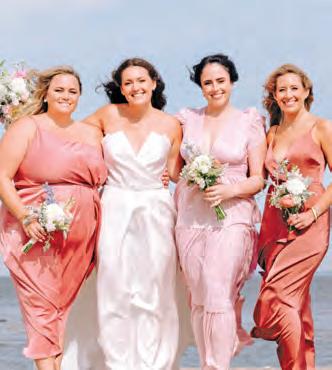
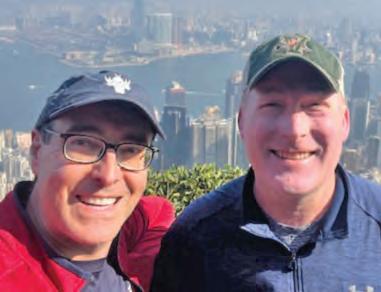


DALINDA IFILL-PRESSAT ’05 isn’t one to wait for an opportunity to find her. Early in her career, stymied by the obstacles that kept her from advancing in the corporate world, she chose a new path that led her to a career she loves. Or, as she puts it, “If there’s no seat at the table, you bring your own table.”
Today, Ifill-Pressat is director of marketing and communications at Children’s Services of Roxbury, a Boston nonprofit that last year celebrated its 50th anniversary. CSR provides human services support for children and families in need. “We’re one of the largest Black-run nonprofits in Massachusetts,” says Ifill-Pressat. She’s thrilled to be in charge of
“shaping CSR’s messaging in a way that uplifts our community.”
Ifill-Pressat, who grew up in Dorchester, arrived at Rivers in middle school, having been supported by the Steppingstone Scholars Program, which positions inner-city youth to apply to exam schools or independent schools. When it came time to select a school, says Ifill-Pressat, “I chose Rivers, despite the distance from my home. When I visited, I loved the community. There was a sense of welcome and a feeling that it was a safe space.”
Much at Rivers was unfamiliar, but the experience, she says, was never overwhelming or alienating. “I had the opportunity and privilege of being in a
community of people who pushed you to stay on the track of wanting more out of life. If you got lost—well, it’s almost like you couldn’t get lost. They wouldn’t let you,” says Ifill-Pressat.
During her undergraduate years at Northeastern, Ifill-Pressat pursued communications and media studies, and she got a job offer at WBZ-TV upon graduation. She stayed for nearly 10 years, hoping to become a reporter or land on the assignment desk. But working on the production side, formatting and segmenting syndicated shows, offered no clear pathway to a newsroom role.
Undaunted, Ifill-Pressat created her own show: “Your Caribbean News and Culture,” which ran on the local public-access cable outlet Boston Neighborhood Network Television. A native of Barbados, Ifill-Pressat was well acquainted with the local Caribbean community, and the project soon became a passion. She also decided that earning a master’s degree in journalism at Emerson College would help her figure out next steps. “TV is its own beast, and it was challenging to see how those skills and tools could be transferred to a different sector,” says Ifill-Pressat. “Grad school gave me the confidence and insight to pivot out of TV.”
After finishing her degree, she pursued several job leads, but, she says, “CSR just felt like home.” She joined the organization in 2019. Although she hadn’t intended to land in the nonprofit sector, the opportunity was too good to turn down: “Being part of what I like to call Black excellence and having that type of impact—I knew this was a place I wanted to be part of.” Ifill-Pressat, it seems, has found her table and claimed her seat there. R
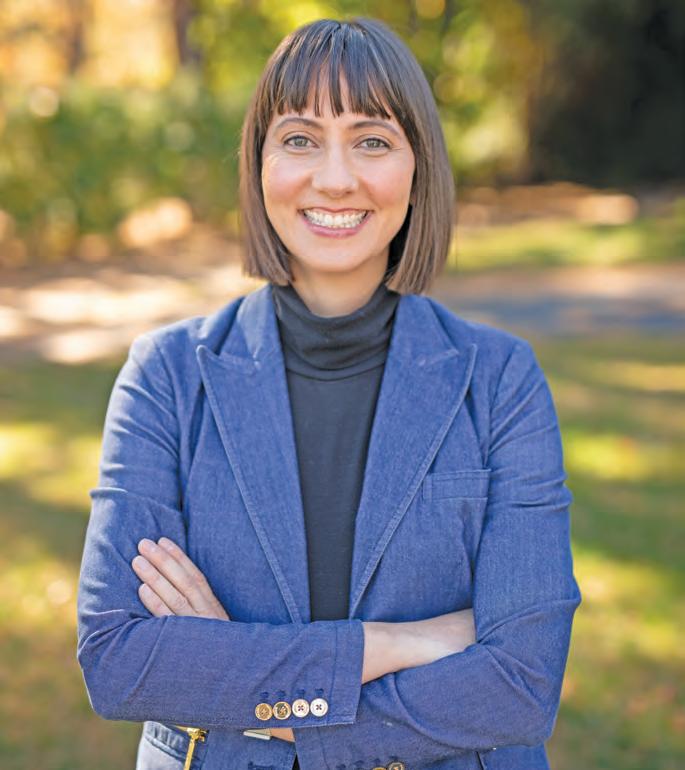
BIOTECH HAS BEEN in the news of late, and so has fintech. And if Bridget O’Connor Garsh ’00 has anything to say about it, famtech—technologies that support caregivers—will also be making headlines in years to come.
Garsh is the chief operating officer at FamTech.org, which she describes as “an industry association focused on helping founders, investors, policymakers, and partners connect and drive forward solutions within the care economy.” The “care economy,” she goes on to say, “sounds like a fancy term, but it’s basically supporting caregivers across a life spectrum, from
cradle to grave.” The organization, which comprises some 300 founder members, supports a sector “that can often be overlooked from a traditional investment perspective.” A startup founder herself, she transitioned to her current role in January.
Many famtech founders—including Garsh—launched their businesses to address an unmet need in their own lives. “I had never thought about child care before I was pregnant,” explains Garsh, whose children are now 6 and 4.
She was one of the lucky ones: Her husband, David Garsh ’99, worked for a company that offered on-site
day care. But when the “incredible teachers” there left, Garsh wondered if there might be a better way—one in which teachers felt empowered to open their own small child care businesses, making the whole model more economically sustainable. To that end, Garsh soon co-founded NeighborSchools, supporting a mission of “better child care for everybody.”
Garsh’s path to famtech was neither linear nor predictable. After graduating from Rivers, she went on to Wellesley College, where she studied psychology and economics. “Everyone had always told me I should be a lawyer,” says Garsh. But a short stint working at a law firm put a decisive end to that ambition. Like many false starts, however, it brought her actual preferences into focus: She knew she wanted to do work that was more compelling and more people-focused. She held several roles in business, working in product marketing and customer success, before taking on a senior advancement position at Wellesley College. While working at Wellesley, she developed the concept for NeighborSchools, launching it in 2019. It was acquired by Higher Ground Education in 2022.
Garsh says her journey was enabled, at least in part, by her Rivers experiences. The school’s emphasis on balance and risk-taking, she says, made her comfortable in a wide variety of roles. Also key was the relationships she built with faculty members. “I knew that they cared about me deeply and saw potential in me before I could see it in myself,” she says. “That level of encouragement gave me the confidence that I could do something if I set my mind to it.” R
Andrew Flake ’67 writes, “I retired in 2023 after 50 years as owneroperator of Andrew A. Flake Inc. My company developed a reputation for building some of the finest homes and estates on Martha’s Vineyard. I am thoroughly enjoying retirement and finding myself almost as busy, giving back to the community in areas that are important to me. Our three daughters now live in Maui, Boston, and the Vineyard. The oldest moved back to the island from L.A. with her husband to take over my sister’s real estate firm. We have one granddaughter, who is a joy. I remain very active in recreational sports and look forward to more travel and time with my wife of 49 years, June. I continue to stay in touch with a few of my classmates and look forward to our next reunion at Rivers. I marvel at how Rivers has grown in so many ways!”
Randy Plimpton ’70 shares, “I moved from North Carolina to Rochester, NY, in 2020 to be closer to one of my children during COVID. Since then, I’ve started the Plimpton Foundation (theplimptonfoundation. org), whose mission I’m very proud of. When not working on foundation, business I play tennis five to six times a week. I’m thoroughly enjoying the cold and snow versus the heat and humidity of North Carolina.”
Tom Kealy ’84 writes, “In December 2023, I completed my term as dean of business and social sciences at Colby-Sawyer College in New Hampshire and started a new role as director of faculty awards in the provost’s office at Clemson University in South Carolina. It’s a great job, but I already miss the snow!”
Stephen Lable ’90 and Tom Shea ’90 hiked the Peak in Hong Kong. Stephen has lived in Hong Kong for 10 years and Tom has lived in Hong Kong for one month. Tom’s wife, Sara Burns-Sacknoff Shea ’92, will be joining Tommy soon. The Rivers Hong Kong Alumni Association now has

MEGAN KERBS ’12 got married in August 2023. Left to right: Jessie Kraft ’12, Kelsey Young ’12, Meghan McAneny ’12, Megan, Brooke Stoller ’12, and Julia Taylor ’12.
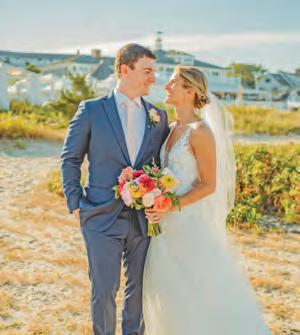


two members, soon to be three! Dave Olverson ’92 is living in Durham, NC, where he has a 5-yearold daughter and twin 3-year-old sons. He is doing small-scale infill development work (building small stuff) and zoning code reform advocacy (changing unfair building rules).
Kathleen Ball ’07 writes, “Married! Our wedding was on September 2, 2023, at Samoset Resort in Rockport, Maine. My husband’s name is Jeff Wilkins. We had 13 fellow Rivers alumni in attendance including Amanda Korff ’07, Jennifer Post ’07, Taylor Hoffman ’07, Nikki (Schuster) O’Brien ’07, Billy Duplisea ’07 and Meghan (Hesselmann) Duplisea ’07, Kadie (Greenfield) Yannone ’07, Stephanie Shaw ’07, Greg Clifford ’08, Chris Whittier ’07, Rob Shanfeld ’07, Nick Jenkins ’07, and Daniel Korff ’10.”
Brooke (Stoller) Melia ’12 writes, “Married and first baby—Stephen Patrick Melia.”
Megan Kerbs ’12 writes, “I got married on April 29, 2023, and had my best girlfriends from Rivers by my side!”
Zachary Zhang ’18 writes: “Hello, Rivers community! I hope things are going well. I’ve been at Officer Candidate School for the Navy down in Newport, RI, for the past couple of months—it’s been crazy, but honestly, a lot of the leadership skills I learned at Rivers are still applied here. I still have my phone for just the holiday stand down, but I have only a few weeks left—hoping to have more good news to share of my graduation soon!”

September 13, 1927–February 7, 2024
FORMER HEAD OF SCHOOL David M. Berwind passed away on February 7 at the age of 96. Berwind served as the fourth headmaster at Rivers from 1968 to 1981. A beloved history teacher, Berwind joined the faculty in 1958 and served as head of the Lower School before becoming headmaster.
A 1950 graduate of Bowdoin College, Berwind was a leader who engaged and motivated those around him. He bolstered faculty support by helping establish an endowment to supplement salaries and fund sabbaticals, while supporting the acquisition of faculty housing.
Berwind oversaw an extensive expansion of the curriculum at Rivers. Under his leadership, the arts program flourished. One long-lasting piece of his legacy was the creation of the Rivers Music School, which evolved into The Rivers School Conservatory of today.
Other facets of Rivers life introduced during Berwind’s tenure included English Department electives, a community service requirement, and annual trips to Camp Chewonki by Grade 7 and Grade 9 students. Athletics grew during his Rivers years as well, with varsity hockey returning to Rivers in 1975.
In 1986, the Berwind Building was dedicated in his honor. He remained connected to Rivers as a Life Trustee. Berwind is survived by three children, six grandchildren, and four great-grandchildren.
David Preston ’51, March 26, 2024
Newell M. Stultz ’51, January 12, 2024
Harry B. Bradley ’54, May 13, 2023
John L. McConchie, Jr. ’56, October 11, 2023
William A. Christmas ’57, October 8, 2023
Kenneth R. Sherman ’57, February 27, 2024
John E. Hurwitch ’59, January 12, 2024
Stanley D. Prescott ’62, January 23, 2024
David D. Jones ’70, October 22, 2023
Peter M. Webber ’70, December 26, 2023
Jeffrey L. Roehr ’77, February 23, 2024
James I. Ladge ’86, September 29, 2023
SAVE THE DATE!

SATURDAY, OCTOBER 26, 2024 | 2:00–8:00 P.M.


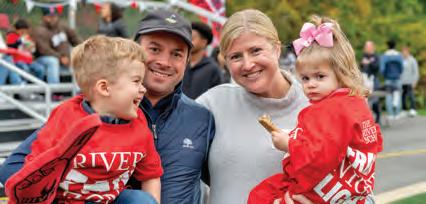
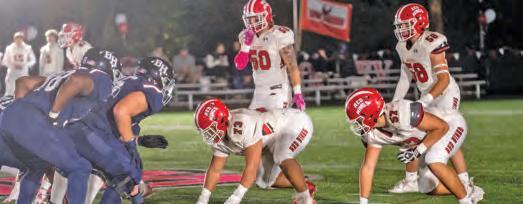




We’ve got a few new plans in the works for Homecoming, making this fall favorite even more fun and family-friendly. Bring the gang to enjoy a Rivers pop-up shop with new merchandise, fun food trucks, and some fresh twists! And of course, there will be athletic events throughout the day, culminating with a varsity football showdown under the lights. Mark your calendars. We hope to see you there!

